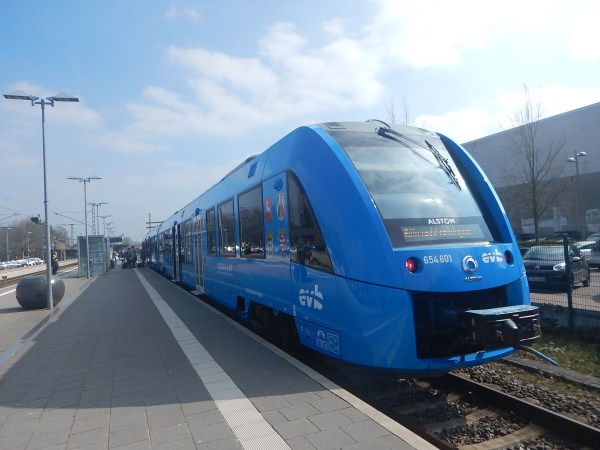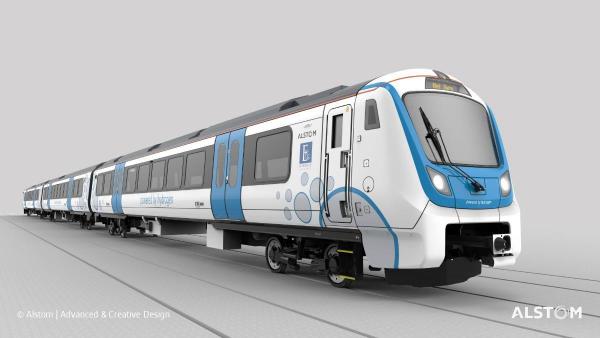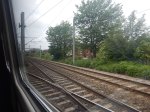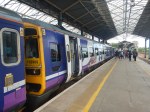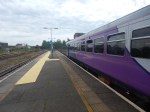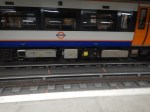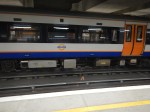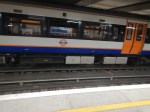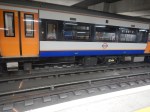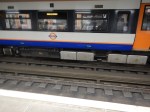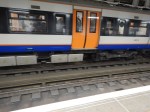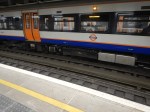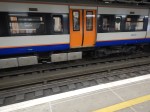Is Alstom’s Proposal For A Service Between London Euston And Wrexham Part Of A Cunning Plan?
Alstom have built and introduced into service between Buxtehude and Cuxhaven in Germany, the Coradia iLint hydrogen-powered train. The prototype has performed demonstrations in Austria, Canada, The Netherlands and Saudi Arabia.
This picture shows a Coradia iLint in Germany.
In the UK, Alstom had a plan to convert redundant Class 321 trains into a fleet of hydrogen-powered trains called Breeze, which I wrote about in Hydrogen Trains Ready To Steam Ahead, in January 2019.
This visualisation is from Alstom.
I suspect it didn’t appeal to train companies, as no orders appear to have been received.
But you can’t criticise Alstom for not trying, as in November 2021, they signed an agreement with Eversholt Rail Group to develop a hydrogen-powered Aventra, which I wrote about in Alstom And Eversholt Rail Sign An Agreement For The UK’s First Ever Brand-New Hydrogen Train Fleet.
This visualisation is from Alstom.
Visually, it looks just like any other Aventra and much better than the previous Breeze design.
In March 2018, I wrote Bombardier Bi-Mode Aventra To Feature Battery Power, which was based on this article in Rail Magazine.
These are a few points from the article.
- Development has already started.
- Battery power could be used for Last-Mile applications.
- The bi-mode would have a maximum speed of 125 mph under both electric and diesel power.
- The trains will be built at Derby.
- Bombardier’s spokesman said that the ambience will be better, than other bi-modes.
- Export of trains is a possibility.
- Bombardier’s spokesman also said, that they have offered the train to three new franchises. East Midlands, West Coast Partnership and CrossCountry.
Have Alstom looked at what they bought from Bombardier and decided the following train is possible, if they add some of their technology?
- A train the size needed by the customer, up to a length of at least ten cars.
- 125 mph under 25 KVAC overhead electrification.
- 100 mph with 750 VDC third rail electrification.
- Running on hydrogen away from electrification.
- 100 mph maximum speed running on hydrogen.
- A range of perhaps 500 miles, if it can emulate the hydrogen-powered Coradia iLint.
A train with this specification would have several applications in the UK.
- Fully-electric routes.
- Electric routes with perhaps a hundred miles of unelectrified track.
- Scenic routes, where the Nimbies wouldn’t like electrification.
These points should also be born in mind.
- There are now 110 mph Aventras in service with West Midland Trains on the West Coast Main Line.
- I recently came back from Cardiff to London in a twelve-car Class 387 train and there wasn’t too many unhappy passengers. It was certainly better than a rail replacement bus. I wrote about the trip in Cardiff To Reading In A Class 387 Train.
- Alstom believe you can certainly fit their hydrogen gubbins in an Aventra.
- The hydrogen gubbins appear to be from Cummins, who have a worldwide support network.
- Cummins can also supply complete hydrogen support systems. A truck can refuel the train, at one end of the route?
- Alstom have been doing the market research with the hydrogen-powered Coradia iLint, so I suppose they know what the market needs.
Could Alstom, with help from Cummins, have a zero-carbon 200 kph train and support systems, which has a hydrogen range of up to a thousand kms for export markets like the United States, Africa, Australia, India and South America?
Two big world-leading companies are surely better than one!
But Alstom has one big problem!
How do you fully test a 125 mph hydrogen-powered train?
- I know with aircraft, if you change the engine type on an existing aircraft, you only have to certify the engine and this is done on a Supplementary Type Certificate.
- Is it the same with trains, so a 110 mph Class 730 train, which is in service with West Midlands Trains, could be the basis of certifying a hydrogen-powered Aventra?
- The Coradia iLint was only a change from diesel to a hybrid hydrogen-electric engine, so was it certified this way?
- With the Coradia iLint, it seemed to go into service quite quickly, so did it do much of the testing in service?
I looks to me, that London Euston and Wrexham is an ideal route for a hydrogen bi-mode 125 mph train.
- The route has electrified sections, some of which have high operating speeds.
- The route has a convenient hydrogen supply from INEOS at Runcorn at the Northern end.
- Change between hydrogen and electric power would always take place in a station.
- A round trip needs less than 200 miles of running on hydrogen.
- South of Nuneaton, no hydrogen is used, so the train will be like a Class 730 train, that already uses the route.
- There are depots that can service Aventras on the route.
It is certainly a possibility, that the London Euston and Wrexham servicewill be used to test and showcase Alstom’s new Hydrogen Aventra.
Chiltern Electrification Alternatives Studied
The title of this post, is the same as that of this article on Railway Gazette.
These are the first two paragraphs.
Chiltern Railways is working to present the Department for Transport with options for a fleet renewal programme, with London Marylebone being the only non-electrified London terminal and pressure for the withdrawal of diesel trains continuing to mount, particularly from local residents.
Industry insiders report that this could see at least the 39 two and three-car Class 165 diesel multiple-units replaced.
Note.
- The Class 165 trains were built in 1990-1992 and refurbished around the turn of the century.
- Chiltern Railways have 28 two-car and 11 three-car Class 165 trains.
- Chiltern Railways also have ten similar two-car, nine three-car and nine four-car Class 168 trains.
- In addition, Great Western Railway has 20 two-car and 16 three-car Class 165 trains, and 23 Class 166 trains.
- The Class 165 and Class 166 trains are 90 mph units, whereas the Class 168 trains are 100 mph units.
As Chiltern’s study would appear to rule out electrification, could all of these trains be replaced with an appropriate number of a new class of 100 mph zero-carbon independently-powered multiple units?
In Alstom And Eversholt Rail Sign An Agreement For The UK’s First Ever Brand-New Hydrogen Train Fleet, I talked about a proposed hydrogen train fleet.
These trains are described as three-car in Alstom’s press release.
- Most Aventras are 100 mph trains.
- They could easily be lengthened to four cars by the addition of an extra car.
- It may even be possible, that these trains could be fitted with a pantograph for working on electrified lines.
The only problem, I can envisage, is that a two-car version might not have enough space for the hydrogen and electrical gubbins.
Chiltern’s Locomotive-Hauled Mark III Stock
Greater Anglia have replaced locomotive-hauled Mark III stock with multiple units and it appears to have been successful.
Could Chiltern’s locomotive-hauled Mark III stock be replaced by six-car hydrogen-powered Aventras, with a long-distance interior?
Other Routes
Alstom and Eversholt Rail announced their agreement in November 2021.
Since then, I have written these posts, where the proposed Alstom Hydrogen Aventra could have an application.
- Adding Buxton And Manchester Piccadilly To The Bee Network
- ‘Castle’ HSTs To Be Withdrawn By Great Western Railway
- Proposals Submitted To Create Darlington To Dales Rail Link
- Alstom Hydrogen Aventras And Teesside
- Alstom Hydrogen Aventras And The Reopened Northumberland Line
- Alstom Hydrogen Aventras And Extension Of The Birmingham Cross-City Line
- Alstom Hydrogen Aventras And Great Western Branch Lines Between Paddington And Oxford
- Alstom Hydrogen Aventras And The Uckfield Branch
Note.
- A two-car version would surely increase the number of applications.
- A 110 mph capability would allow the trains to mix it with high speed trains on fast lines.
- Bombardier proposed a 125 mph bi-mode Aventra. Could this be achieved with hydrogen power?
I feel the eight applications, I listed, could be the start of something a lot bigger.
Conclusion
Alstom and Eversholt Rail Group appear to have done their research.
Vere Promises East Midlands Bi-Modes In 2022
The title of this post is the saqme as that of this article on Rail Magazine.
This is the first paragraph.
East Midlands Railway will have its entire bi-mode fleet in traffic by December 2022, according to Baroness Vere, the Government’s transport spokesman in the House of Lords.
This statement means that whoever manufactures the trains has just over three years from today to design, build and test the trains.
This paragraph from the article talks about how Bombardier and Hitachi would design the trains.
It’s known that Bombardier and Hitachi are interested in the contract, but both will be supplying new designs, with the former offering a bi-mode Aventra while the latter will offer an AT300 (the Intercity Express Programme platform) but with shorter vehicles.
What do we know about these two trains?
Bombardier Bi-Mode Aventra
In the July 2018 Edition of Modern Railways, there is an article entitled Bi-Mode Aventra Details Revealed.
As is typical with Bombardier interviews, they give their objectives, rather than how they aim to achieve them.
In Bombardier Bi-Mode Aventra To Feature Battery Power, I said this.
The title of this post is the same as this article in Rail Magazine.
A few points from the article.
- Development has already started.
- Battery power could be used for Last-Mile applications.
- The bi-mode would have a maximum speed of 125 mph under both electric and diesel power.
- The trains will be built at Derby.
- Bombardier’s spokesman said that the ambience will be better, than other bi-modes.
- Export of trains is a possibility.
Bombardier’s spokesman also said, that they have offered the train to three new franchises. East Midlands, West Coast Partnership and CrossCountry.
Very little more can be gleaned from the later Modern Railways article.
Consider.
- Aventras are designed to a modular concept.
- Bombardier have finally got the software for the train working to a high standard.
- The trains are designed for ease of manufacture, at a high rate.
- Development of the bi-mode train must have started before June 2018.
- Christian Wolmar disclosed the objective of a 125 mph Aventra in February 2017.
- I have seem references to Aventras, being tested at 110 mph.
On the balance of probabilities, I think it is very possible that Bombardier can deliver a full fleet of 125 mph bi-mode trains with batteries before the end of 2022.
Hitachi AT-300
Consider.
- Class 802 trains are a version of the AT-300 train, which in turn are a member of Hitachi’s A-Train family.
- Class 802 trains are successfully in service on the Great Western Railway.
- Class 385, 395, 800 and 801 are all members of the A-train family and are closely related to the Class 802 train.
- The A-Train is a modular family.and different numbers of cars and car length, shouldn’t be a problem.
- Hull Trains ordered their fleet of five Class 802 trains in November 2016 and they will enter service around December 2019 or early in 2020.
- First Group ordered five AT-300 trains in March 2019 and they will enter service in Autumn 2021.
If the order has been placed in the last few months, there is every chance that Hitachi could deliver a fleet of new bi-mode trains for service in December 2022.
Stadler Flirt
These aren’t mentioned in the Rail Magazine article, but they were mentioned as a possibility for the order in an article by Roger Ford, which was entitled East Midlands IC125 Dilemma, in the June 2019 Edition of Modern Railways.
This is an extract from Roger’s article.
In theory, Stadler should be in pole position. Itis also supplying Abellio’s Greater Anglia franchise, where Flirt bi-modes are running on test.
As they haven’t had any serious problems yet, and they are Swiss, everyone thinks they are amazingly efficient and wonderful. Whjich may turn out to be the case.
In the end, Roger rates their chances as slim.
But Stadler certainly has the technical capability to produce a 125 mph bi-mode train.
Electric Trains To Corby
When the electrified St. Pancras and Corby service opens in December 2020, a round trip will take three hours.
This means that as few as three trains would be needed to provide the service.
The specification would be.
- Electric traction
- Twelve cars and 240 metres long.
- 125 mph capability.
- Three trains and a spare would probably be needed by December 2020, with a further three trains by December 2021.
Abellio would also probably like the trains to be very similar for drivers and staff.
Currently, it appears that the electric services to Corby, will be run initially by cascaded Class 360 trains.
- But with a bit of juggling of production, Bombardier, Hitachi and Stadler might be able to manufacture, the four trains needed to start the service in December 2020.
- Abellio also have Class 360 and Class 379 trains working on Greater Anglia, that are likely to be replaced before December 2020.
So they have a sensible back-stop.
How Many Trains Will Abellio Need?
The current service is two trains per hour to both Nottingham and Sheffield.
These are fastest times.
- London and Nottingham is one hour forty minutes
- London and Sheffield is two hours
Even if there is a bit of a speed increase, it looks like at least eight trains will be needed for both services.
As to train length, I doubt five cars will be enough on all trains.
- Some services are currently run by six and eight-car HSTs.
- Have Abellio promised more seats?
- Abellio will be extending some Sheffield services to Rotherham, Barnsley and Leeds.
- It has already been stated that the Corby trains will be 240 metres long
- So will we see a uniform fleet of longer trains?
There are some short platforms, so I suspect Abellio will buy a mixture of full-length 240 metre-long trains and half-length 120 metre-long trains, as several train companies have done.
I feel we could see something like eight full length trains and perhaps twelve half-length trains.
I have calculated that seven full-length trains are needed for Corby.
Adding this up gives the following.
- Eight full-length bi-mode trains of ten-cars.
- Seven full-length electric trains of ten-cars.
- Twelve half-length bi-mode trains of five-cars
This gives a total of 27 trains of a total of 210 cars, of which 140 are bi-mode and 70 are electric.
All of this is based on running the current service with new trains.
abellio Greater Anglia have not not just done this in East Anglia, but have purchsed extra trains to add new services and increase frequencies.
So I would feel, that these trains are a minimum order, if Abellio are not doing any expansion.
Daily Telegraph Report – 19th July 2019
A report in the Daily Telegraph on the 19th July 2019, which is entitled Blow For Bombardier’s Derby Plant As £600m Train Contract Goes To Hitachi, says the order has gone to Hitachi.
- Value is quoted at £600million.
- A formal announcement is expected next week.
Has next week already passed without an announcement from Abellio?
I do find it strange, that there has been no reference to the Telegraph report in local sources around Derby.
This article on Railway Gazette is entitled Trains Ordered For 2021 Launch Of ‘High-Quality, Low Fare’ London – Edinburgh Service.
FirstGroup have ordered AT-300 trains.
- All-electric.
- Five trains of five-cars.
- A total order value of £100 million.
- Order placed in March 2019
- Service starting in Autumn 2021
This works out at four million pounds per car.
Earlier, I calculated that Abellio needed to buy 140 bi-mode cars and seventy electric ones.
Assuming that Abellio run the Corby services with refurbished Class 360 trains, then 140 carriages will cost £560 million.
But this would mean the following.
- Abellio would be running two separate fleets on the Midland Main Line.
- The Corby services would run below the operating speed of the route.
- Expansion would mean the purchase of more trains.
This is very different to their philosophy in Abellio Greater Anglia.
- Class 745 and Class 755 trains are very similar to drivers and other staff.
- Both trains can operate at 100 mph on the Great Eastern Main Line.
- Abellio Greater Anglia have significantly increased the size of their train fleet.
I believe that Bombardier, Hitachi and Stadler can all met this schedule.
- Deliver four 125 mph electric trains by a date early enough for a December 2020 start for Corby services.
- Deliver another three 125 mph electric trains by December 2021 for two trains per hour to Corby.
- Deliver the fleet of 125 mph bi-mode electric trains by December 2022 for Derby,Nottingham, Sheffield and beyond.
At four million pounds for a car for a Hitachi train, this works out at £840 million.
So could it be, that Hitachi have thrown in a good discount to make sure of the order.
It will be very interesting, when Abellio announce their order.
Interim Trains
Baroness Vere also discussed the other trains on the Midland Main Line.
This was the final two paragraph from the article.
As it stands, the 12 High Speed Trains cannot operate in passenger traffic beyond December 31 2019 this year, as they will not meet new accessibility regulations.
When announcing the Abellio contract win in April, Government confirmed that four Class 180s would transfer from Hull Trains to EMR. There was also the possibility that the LNER HSTs could also transfer to the MML, although these do not meet the disability requirements either.
So what is going to happen?
It appears that the four Class 180 trains and the twenty-seven Class 222 trains of various lengths will have to manage.
But I do think, that Baroness Vere’s statement.
East Midlands Railway will have its entire bi-mode fleet in traffic by December 2022.
Is very welcome, as the HSTs will retire on the 31st December 2019 and there will be less than three years of a reduced fleet.
These points should also be noted.
- In December 2020, when the electrification goes live and new electric trains start running between London and Corby, there will be a few more Class 222 trains available.
- The Corby electric trains, will also add capacity between London and Kettering.
- I don’t think it unlikely, that some other trains are rustled up to fill the gaps using perhaps Mark 4 coaches and Class 43 locomotives.
I hope for Abellio’s and their passengers sake, that what Baroness Vere said, comes true!
Could Abellio Go For A Safety-First Solution?
Consider.
- Abellio Greater Anglia’s new Class 745, Class 755 and Class 720 trains are all running, if not years, but a few months late.
- There has been nothing serious and Greater Anglia only has one fleet that is not PRM-compliant; the London and Norwich expresses.
- Providing all goes reasonably well with the introduction of the new Class 745 trains, Greater Anglia’s fleet will be fully PRM-compliant, by the end of the year.
But if they had opted for off-the-shelf Hitachi Class 801 trains for London and Norwich, there might have been less worry. On the other hand, Hitachi way of making trains, by shipping the bodies from Japan probably doesn’t lead itself to high productio rates.
But for Midland Main Line services, Abellio East Midlands Railway aren’t looking at a large fleet of trains.
I estimate they could need.
- Eight full-length bi-mode trains of ten-cars.
- Seven full-length electric trains of ten-cars.
- Twelve half-length bi-mode trains of five-cars
Now that Hitachi’s big orders are coming to an end, Abellio can probably be sure, they will get the main line trains on time and with the minimum of fuss.
Going the safety-first route of buying a fleet of Hitachi trains could deliver the trains that are needed urgently.
- Four 125 mph electric trains by a date early enough for a December 2020 start for Corby services.
- Another three 125 mph electric trains by December 2021 for two trains per hour to Corby.
- A fleet of 125 mph bi-mode electric trains by December 2022 for Derby,Nottingham, Sheffield and beyond.
It might be a bit tight for the Corby electrics, but other trains that could work the route in the interim are available.
Abellio could do a lot worse than give Hitahi the order, if they could deliver early!
Conclusion
If any of the three train manufacturers can supply new trains for the St. Pancras and Corby service to the tight timetable, Abellio would surely be very pleased, as they would only have one train type to introduce on the route.
But I do think, that there is a possibility, that a good discount has won it for Hitachi!
Manchester Victoria To Chester
On Saturday, I went between Manchester Victoria and Chester on the new hourly Northern Connect service between Chester and Leeds.
Note.
- The train was a Class 158 train, with a Class 153 train acting as a capacity enhancer.
- The train was only doing 60 mph on the West Coast Main Line.
- The service was fairly busy.
- The route is electrified between Manchester Victoria and Warrington Bank Quay stations.
On this Saturday morning, it appeared to me that a better train is needed.
In Northern Connect Between Chester And Leeds To Start In May, I did report a rumour that Class 769 trains might be running between Chester and Leeds.
In my view Class 769 trains are ideal for the route between Chester and Leeds.
- They are four-car trains.
- They can do 100 mph, where electrification is available.
- They are 90 mph trains on diesel.
There main problem, is not their age, but since they were proposed, train interiors have moved on. Passengers and train operating companies want more tables and comfortable seats. Even some refurbishments of forty-year-old trains have tables. In What Train Is This?, I described a high class refurbishment of a Class 150 train. Here’s a picture.
The Chester and Leeds route and probably many other routes in the UK need a train with the following characteristics.
- 100 mph using either 25 KVAC overhead or 750 VDC third-rail electrification.
- 100 mph on secondary power like diesel, battery or hydrogen.
- two hundred mile range without refuelling.
- Four or five cars.
- Comfortable interior with tables, wi-fi, power points and everything else passengers want.
Train operating companies would probably like a 125 mph version.
Hitachi already have a train with this specification in the Class 800 train. In Hitachi Plans To Run ScotRail Class 385 EMUs Beyond The Wires, I detail, Hitachi’s plans for Class 385 trains. Could these be stretched to perhaps do 100 miles on batteries.
Bombardier are offering a High Speed Bi-Mode Aventra with batteries and Stadler are introducing the Class 755 train for Greater Anglia.
Conclusion
It looks to me, that Northern need to get themselves some new 100 mph hybrid trains. The diesels they have on order are so Twentieth Century and late!
Hydrogen Trains To Be Trialled On The Midland Main Line
This article on Railway Gazette is entitled Bimode And Hydrogen Trains As Abellio Wins Next East Midlands Franchise.
Abellio will be taking over the franchise in August this year and although bi-mode trains were certain to be introduced in a couple of years, the trialling of hydrogen-powered trains is a surprise to me and possibly others.
This is all that is said in the article.
Abellio will also trial hydrogen fuel cell trains on the Midland Main Line.
It also says, that the new fleet will not be announced until the orders are finalised.
In this post, I’m assuming that the hydrogen trial will be performed using the main line trains.
Trains for the Midland Main Line will need to have the following properties
- 125 mph on electric power
- 125 mph on diesel power
- Ability to go at up to 140 mph, when idigital n-cab signalling is installed and the track is improved.
- UK gauge
- Ability to run on hydrogen at a future date.
I think there could be three types of train.
- A traditional bi-mode multiple unit, with underfloor engines like the Hitachi Class 800 series, is obviously a possibility.
- An electrical multiple unit, where one driving car is replaced by a bi-mode locomotive with appropriate power.
- Stadler or another manufacturer might opt for a train with a power pack in the middle.
The second option would effectively be a modern InterCity 225.
- South of Kettering, electricity would be used.
- North of Kettering, diesel would be used
- Hydrogen power could replace diesel power at some future date.
- Design could probably make the two cabs and their driving desks identical.
- The locomotive would be interchangeable with a driver car.
Bi-modes would work most services, with electric versions working to Corby at 125 mph.
Which manufacturer has a design for a 125 mph, hydrogen-powered train?
Alstom
Alstom have no 125 mph UK multiple unit and their Class 321 Hydogen train, is certainly not a 125 mph train and probably will still be under development.
Bombardier
In Mathematics Of A Bi-Mode Aventra With Batteries, I compared diesel and hydrogen-power on bi-mode Aventras and felt that hydrogen could be feasible.
In that post, I wrote a section called Diesel Or Hydrogen Power?, where I said this.
Could the better ambience be, because the train doesn’t use noisy and polluting diesel power, but clean hydrogen?
It’s a possibility, especially as Bombardier are Canadian, as are Ballard, who produce hydrogen fuel-cells with output between 100-200 kW.
Ballard’s fuel cells power some of London’s hydrogen buses.
The New Routemaster hybrid bus is powered by a 138 kW Cummins ISBe diesel engine and uses a 75 kWh lithium-ion battery, with the bus being driven by an electric motor.
If you sit in the back of one of these buses, you can sometimes hear the engine stop and start.
In the following calculations, I’m going to assume that the bi-mode |Aventra with batteries has a power source, that can provide up to 200 kW, in a fully-controlled manner
Ballard can do this power output with hydrogen and I’m sure that to do it with a diesel engine and alternator is not the most difficult problem in the world.
So are Bombardier designing the Bi-Mode Aventra With Batteries, so that at a later date it can be changed from diesel to hydrogen power?
All an Aventra needs to run is electricity and the train, the onboard staff and passengers don’t care whether it comes from overhead wires, third-rail, batteries, diesel or hydrogen.
Bombardier also have the technology for my proposed locomotive-based solution, where one driver-car of an Aventra is replaced by what is effectively a locomotive.
If Bombardier have a problem, it is that they have no small diesel train to replace Abellio’s small diesel trains. Could the longer services use the bi-mode Aventras and the shorter ones Aventras with battery power?
CAF
CAF probably have the technology, but there would be a lot of development work to do.
Hitachi
Hitachi have the bi-mode trains in the Class 802 trains, but haven’t as yet disclosed a hydrogen train.
Siemens
They’ve made a few noises, but I can’t see them producing a bi-mode train for 2022.
Stadler
In a few weeks time, I will be having a ride in a Stadler-built Class 755 train, run by Abellio Greater Anglia.
The Class 755 train is a bi-mode 100 mph train, from Stadler’s Flirt family.
Could it be stretched to a 125 mph train?
- Stadler have built 125 mph electric Flirts.
- It is my view, that Stadler have the knowledge to make 125 mph trains work.
- Flirts are available in any reasonable length.
- I’ve read that bi-mode and electric Flirts are very similar for drivers and operators.
These could work the Midland Main Line.
If the mainline version is possible, then Abellio could replace all their smaller diesel trains with appropriate Class 755 trains, just as they will be doing in East Anglia.
Stadler with the launch of the Class 93 locomotive, certainly have the technology for a locomotive-based solution.
East Midlands Railway would be an all-Stadler Flirt fleet.
As to hydrogen, Stadler are supplying hydrogen-powered trains for the Zillertalbahn, as I wrote in Zillertalbahn Orders Stadler Hydrogen-Powered Trains.
Talgo
Talgo could be the joker in the pack. They have the technology to build 125 mph bi-mode trains and are building a factory in Scotland.
My Selection
I think it comes down to a straight choice between Bombardier and Stadler.
It should also be noted, that Abellio has bought large fleets from both manufacturers for their franchises in the UK.
Zero-Carbon Pilots At Six Stations
This promise is stated in the franchise.
Once the electrification reaches Market Harborough in a couple of years, with new bi-mode trains, running on electricity, the following stations will not see any passenger trains, running their diesel engines.
- St. Pancras
- Luton Airport Parkway
- Luton
- Bedford
- Wellingborough
- Kettering
- Corby
- Market Harborough
These are not pilots, as they have been planned to happen, since the go-ahead for the wires to Market Harborough.
Other main line stations include.
- Beeston
- Chesterfield
- Derby
- East Midlands Parkway
- Leicester
- Long Eaaton
- Loughborough
- Nottingham
- Sheffield
Could these stations be ones, where East Midlands Railway will not be emitting any CO2?
For a bi-mode train to be compliant, it must be able to pass through the station using battery power alone.
- As the train decelerates, it charges the onboard batteries, using regernerative braking.
- Battery power is used whilst the train is in the station.
- Battery power is used to take the train out of the station.
Diesel power would only be used well outside of stations.
How would the trains for the secondary routes be emission-friendly?
- For the long Norwich to Derby and Nottingham to Liverpool routes, these would surely be run by shorter versions of the main line trains.
- For Stadler, if secondary routes were to be run using Class 755 trains, the battery option would be added, so that there was no need to run the diesel engines in stations.
- For Bombardier, they may offer battery Aventras or shortened bi-modes for the secondary routes, which could also be emission-free in stations.
- There is also the joker of Porterbrook’s battery-enhaced Class 350 train or BatteryFLEX.
I think that with the right rolling-stock, East Midlands Railway, could be able to avoid running diesel engines in all the stations, where they call.
Why Are Abellio Running A Hydrogen Trial?
This is a question that some might will ask, so I’m adding a few reasons.
A Train Manufacturer Wants To Test A Planned Hydrogen Train
I think that it could be likely, that a train manufacturer wants to trial a hydrogen-powered variant of a high-speed train.
Consider.
- The Midland Main Line is about 160 miles long.
- A lot of the route is quadruple-track.
- It is a 125 mph railway for a proportion of the route.
- It has only a few stops.
- It is reasonably straight with gentle curves.
- Part of the route is electrified.
- It is connected to London at one end.
In my view the Midland Main Line is an ideal test track for bi-mode high speed trains.
A Train Manufacturer Wants To Sell A Fleet Of High Speed Trains
If a train manufacturer said to Abellio, that the fleet of diesel bi-mode trains they are buying could be updated to zero-carbon hydrogen bi-modes in a few years, this could clinch the sale.
Helping with a trial, as Abellio did at Manningtree with Bombardier’s battery Class 379 train in 2015, is probably mutually-beneficial.
The Midland Main Line Will Never Be Fully Electrified
I believe that the Midland Main Line will never be fully-electrified.
- The line North of Derby runs through the Derwent Valley Mills World Heritage Site. Would UNESCO allow electrification?
- I have been told by drivers, that immediately South of Leicester station, there is a section, that would be very difficult to electrify.
- Some secondary routes like Corby to Leicester via Oakham might be left without electrification.
But on the other hand some sections will almost certainly be electrified.
- Around Toton, where High Speed Two crosses the Midland Main Line and the two routes will share East Midlands Hub station.
- Between Clay Cross North Junction and Sheffield, where the route will be shared with the Sheffield Spur of High Speed Two.
- The Erewash Valley Line, if High Speed Two trains use that route to Sheffield.
The Midland Main Line will continue to need bi-mode trains and in 2040, when the Government has said, that diesel will not be used on UK railways,
It is my view, that to run after 2040, there are only two current methods of zero-carbon propulsion; on the sections without overhead electrification battery or hydrogen power.
So we should run trials for both!
Abellio Know About Hydrogen
Abellio is Dutch and after my trip to the Netherlands last week, I wrote The Dutch Plan For Hydrogen, which describes how the Dutch are developing a green hydrogen economy, where the hydrogen is produced by electricity generated from wind power.
So by helping with the trial of hydrogen bi-mode trains on the Midland Main Line, are Abellio increasing their knowledge of the strengths and weaknesses of hydrogen-powered trains.
In Thoughts On Eurostar To North Netherlands And North West Germany, I proposed running bi-mode trains on the partially-electrified route between Amsterdam and Hamburg via Groningen and Bremen, which would be timed to connect to Eurostar’s services between London and Amsterdam. These could use diesel, hydrogen or battery power on the sections without electrification.
If hydrogen or battery power were to be used on the European bi-mode train, It would be possible to go between Sheffield and Hamburg on a zero-carbon basis, if all electric power to the route were to be provided from renewable sources.
Abellio Sees The PR Value In Running Zero-Carbon Trains
In My First Ride In An Alstom Coradia iLint, I talked about running hydrogen-powered trains on a hundred mile lines at 60 mph over the flat German countrside
The Midland Main Line is a real high speed railway, where trains go at up to 125 mph between two major cities, that are one-hundred-and-sixty miles apart.
Powered by hydrogen, this could be one of the world’s great railway journeys.
If hydrogen-power is successful, Abellio’s bottom line would benefit.
Conclusion
This franchise will be a big improvement in terms of carbon emissions.
As I said the choice of trains probably lies between Bombardier and Stadler.
But be prepared for a surprise.
Roaming Around East Anglia – What Trains Will Run On The East-West Rail Link?
In my discussions at Newmarket and as I passed through stations like Ipswich, Norwich and Stowmarket, I got to thinking what type and size of train will be used by the East-West Rail Link.
Bi-Mode Trains
The trains will undoubtedly be some form of bi-mode train, as electrification of the whole route has been ruled out.
But the ability to use electrification would undoubtedly be useful, as parts of the route and some stations already have 25 KVAC overhead wires.
- Reading to Didcot
- Milton Keynes to Bletchley
- Around Bedford
- Around Sandy
- Cambridge North to Cambridge
- Around Norwich
- Haughley Junction to Manngtree
With a few other sections likely to be electrified, I suspect that automated pantograph control would be useful.
Operating Speed
Wikipedia states this about the operating speed of the Western section.
In May 2014, Network Rail announced that the line will be opened to 125 mph (200 km/h) running, the current top speed for InterCity services. It is proposed that CrossCountry services, along with Chiltern Railways and London Northwestern Railway services will use the route.
If it is a 125 mph line in places, then surely the trains will have this speed capability.
The 125 mph East-West Rail Link would also open up some fast 125 mph routes, from the South West and South Wales to the East Coast Main Line.
Train Length
The following stations East of Cambridge will be seved by East-West Rail Link trains.
- A14 Parkway
- Attleborough
- Brandon
- Bury St. Edmunds *
- Cambridge *
- Cambridge North *
- Dullingham
- Ely *
- Elmswell
- Ipswich *
- Kennett
- Manningtree *
- Needham Market *
- Newmarket
- Norwich *
- Stowmarket *
- Thetford
- Thrston
- Wymondham
I am fairly sure that stations marked with an asterisk can already take trains with at least eight cars.
It doesn’t appear that there are any stations to the East off Cambridge, that will have a serious restriction on train length.
I would suspect that five, six or eight cars will be used.
I would also suspect that all platforms would be capable of taking two hundred metre long trains. London Overground was caught out, by making the initial platform length too short and it would be tragic, if the East West Rail Consortium made the same mistake.
Will The Trains Be Walk-Through?
The first long-distance walk-through trains will start to appear this year.
As they offer more passenger space, I think that the trains will be walk-through.
Conclusion
I am pretty sure that the trains for the East-West Rail Link will be 125 mph-capable bi-modes of whatever length the East West Rail Consortium thinks is needed.
Consider.
- Many of the Eastern stations already take two hundred metre trains.
- Reading and possibly Oxford can take two five-car Class 800 trains, which have a length of 260 metres.
- Intermediate stations like Bedford, Cambridge and Milton Keynes all have long platforms.
- Other stations will be newly built or like Newmarket will need rebuilding of the platforms.
I think we might see the East-West Rail Consortium, buying the longest trains, they could possibly need.
Trains from the Hitachi Class 800-family must be in the running for the order, but I feel that this order could be ideal for the 125 mph bi-mode Aventra with batteries, which has been proposed to Cross-Country. I wrote about this train in Bombardier Bi-Mode Aventra To Feature Battery Power.
Hybrid Power On The Railways
In my opinion, one of the best hybrid transmissions is that of London’s New Routemaster bus. This description of the drive-train is from Wikipedia.
The bus is a hybrid diesel-electric driven by a battery-powered electric motor, charged by a diesel fuelled generator and recovering energy during braking by regenerative braking.
It is a classic serial hybrid vehicle.
- There is no mechanical connection between the engine and the driving wheels.
- The diesel engine only runs, when the battery charge is low.
- The electric motor is always powered directly from the battery.
- The control systems for the drive-train are very simple.
- It is very efficient, as the engine only runs when needed and regenerative braking is employed.
- The bus can run on battery power only, for short distances.
- The various components of the drive-train can be placed in convenient places and connected by power and control cables.
In the New Routemaster, the components are placed as follows.
- The diesel engine is half-way up the back stairs.
- The battery is under the front stairs.
- The electric motor is under the floor in front of the rear axle.
This flexibility is very useful in a large vehicle.
Hybrid transmissions are starting to be employed on the railways.
These are the applications in use or planned.
Alstom Coradia iLint
The Alstom Coradia iLint is a hydrogen-powered two-car multiple unit.
This video shows the operation of the train.
<span class=”embed-youtube”></span>
It would appear to be a serial hybrid, where the hydrogen fuel-cell charges the battery and this drives the train through an electric motor,
I suspect most hydrogen trains will work in a similar way.
Class 321 Hydrogen Train
Some Class 321 trains are being converted to run on hydrogen. Unlike the Coradia iLint, the trains will also be able to use electricity from electrification.
MTU Hybrid PowerPacks
MTU have produced a Hybrid PowerPack, which is being retrofitted into several trains, including Class 170 trains in the UK.
Class 93 Locomotive
The recently-announced Class 93 locomotive appears to be a hybrid locomotive with a large diesel engine and about 125 kWh of batteries, that can also use electrification.
High Speed Bi-Mode Aventra
I am sure that Bombardier’s proposed High Speed Bi-Mode Aventra, which features batteries and 125 mph running under both diesel and electric power is a hybrid train.
Conclusion
Just as hybrid cars are becoming more numerous, I suspect we’ll be seeing more hybrid trains in the future.
Vivarail And Hoppecke Announce Long-term Supply Of Batteries For Class 230s
The title of this post is the same as that of a press release from Vivarail.
Some extracts.
A 3-car Class 230 can run for 65 miles between charges which means they are more than able to operate numerous routes throughout the UK, and active conversations are taking place with interested operators. Battery trains enable emission-free rail travel in areas where electrification is either non- or only partially existent. The trains are particularly suited to urban routes where authorities wish to eliminate pollution caused by traditional DMUs as well as scenic lines where the natural environment needs protecting.
A Sixty-five mile range is very respectable and a good start.
Currently Vivarail is building a fleet of diesel/battery hybrids to operate the Wrexham-Bidston line for Transport for Wales, where the diesel gensets will be used to charge the batteries not to power the train. This power variant gives the range of a diesel train, the performance of an EMU (with acceleration of 1m p/s/s up to 40 miles per hour) and combines it with emission-free travel. As well as using the genset to charge the batteries the train also has regenerative braking – as do all the battery trains.
The acceleration is up there with a Class 345 train.
Hoppecke’s Lithium Ion batteries are ideally suited for the Class 230s by providing the rapid charging needed for battery trains. Simulations and performance data show that many non-electrified routes can be operated by the Class 230 battery trains and to make this possible in the short-term Vivarail has designed and patented an automatic charging system and battery bank. This means that costs of both infrastructure upgrades and daily operation are hugely minimised – in some cases by millions of pounds.
The batteries will probably be fairly traditional, but reading about Hoppecke on the web, they seem to be a company that believes in service. They also seem to supply back-up power supplies for critical infrastructure like telecommunications and computing.
Note too, that Vivarail have patented their charging system.
Designs for other types of hybrid trains exist including the use of existing OHL with a pantograph and transformer and 3rd rail with shoegear. Additionally, a new hydrogen variant is being developed which, similarly to the diesel hybrid, will exceed the pure battery train’s range of 65 miles.
Other power sources could be added, when they are invented.
A Serial Hybrid Train
The Class 230 trains for Wales are actually serial hybrids, just like one of London’s Routemaster buses. As the Press Release says, the generator set charges the batteries and these drive the train.
In the Press Release the following methods are mentioned for charging the batteries.
- Diesel generators on the train.
- Static charging systems at stations.
- Regenerative braking.
- 25 KVAC overhead line electrification.
- 750 VDC third rail electrification.
- Hydrogen fuel cells.
I wouldn’t be surprised to find that Vivarail have split the control systems into two-more or-less independent systems; one keeps the batteries charged up in an optimal manner and the other links the batteries to the train’s systems and traction motors.
I also suspect that Bombardier’s proposed 125 mph Aventra With Batteries is a serial hybrid.
Conclusion
Is there anything recycled London Underground trains can’t do?
I have read somewhere, that Vivarail have talked about on-board self-service coffee machines!
Could A 125 Mph Electric Train With Batteries Handle The Midland Main Line?
In Bombardier’s 125 Mph Electric Train With Batteries, I investigated a pure electric train based on Bombardier’s proposed 125 mph bi-mode Aventra with batteries.
It would have the following characteristics.
- Electric power on both 25 KVAC overhead and 750 VDC third-rail.
- Appropriately-sized batteries.
- 125 mph running, where possible on electrification and/or battery power.
- Regenerative braking using the batteries.
- Low energy interiors and systems.
It would be a train with efficiency levels higher than any train seen before.
It would also be zero-carbon at the point of delivery.
An Example 125 mph Train
I will use the same size and specification of train, that I used in Bombardier’s 125 Mph Electric Train With Batteries.
- The train is five cars, with say four motored cars.
- The empty train weighs close to 180 tonnes.
- There are 430 passengers, with an average weight of 90 Kg each, with baggage, bikes and buggies.
- This gives a total train weight of 218.7 tonnes.
- The train is travelling at 200 kph or 125 mph.
Travelling at 200 kph, the train has an energy of 94.9 kWh.
I will also assume.
- The train uses 15 kWh per mile to maintain the required line speed and power the train’s systems.
- Regenerative braking is eighty percent efficient.
I will now do a few calculations.
Kettering To Leicester
Suppose one of the proposed trains was running between St. Pancras and Leicester.
- I’m assuming there are no stops.
- In a year or two, it should be able to run as far as Kettering using the new and improved 25 KVAC overhead electrification.
- The train would leave the electrification at Kettering with a full charge in the batteries.
- The train would also pass Kettering as close to the line speed as possible.
- Hopefully, the twenty-nine miles without electrification between Kettering and Leicester will have been updated to have the highest possible line speed, with many sections capable of supporting 125 mph running.
I can do a rough-and-ready calculation, as to how much energy has been expended between Kettering and Leicester.
- Twenty-nine miles at 15 kWh per mile is 435 kWh.
- The train has a kinetic energy of 94.9 kWh at 125 mph and twenty percent will be lost in stopping at Leicester, which is 19 kWh.
This means that a battery of at least 454 kWh will be needed to propel the train to Leicester.
Kettering To Sheffield
If the train went all the way without stopping between Kettering and Sheffield, the energy used would be much higher.
One hundred-and-one miles at 15 kWh is 1515 kWh.
So given that the train will be slowing and accelerating, we’re probably talking of a battery capacity of around 2000 kWh.
In our five-car example train, this is 400 kWh per car.
Kettering To Sheffield With Stops
The previous calculation shows what can be achieved, but we need a practical train service.
When I last went to Sheffield, the train stopped at Leicester, Loughborough, East Midlands Parkway, Long Eaton, Derby and Chesterfield.
I have built an Excel spreadsheet, that models this route and it shows that if the train has a battery capacity of 2,000 kWh, the train will get to Sheffield with 371 kWh left in the battery.
- Increase the efficiency of the regenerative braking and the energy left is 425 kWh.
- Reduce the train’s energy consumption to 12 kWh per mile and the energy left is 674 kWh.
- Do both and the energy left is 728 kWh.
The message is clear; train manufacturers and their suppliers should use all efforts to improve the efficiencies of trains and all of their components.
- Aerodynamics
- \Weight savings
- Bogie dynamics
- Traction motors
- Battery capacity and energy density
- Low energy lighting and air-conditioning
No idea however wacky should be discarded.
Network Rail also has a part to play.
- The track should have as a high a line speed as is practical.
- Signalling and timetabling should be designed to minimise interactions with other services.
Adding all these together, I believe that in a few years, we could see a train, that will consume 10 kWh per mile and have a regenerative braking efficiency of ninety-five percent.
If this can be achieved then the train will have 960 kWh in the batteries when it arrives in Sheffield.
Sheffield To Kettering
There is no helpful stretch of electrification at the Sheffield end of the route, so I will assume that there is a method of charging the batteries at Sheffield.
Unsurprisingly, as the train is running the same total distance and making the same number of stops, if the train starts with a full battery at Sheffield, it arrives at Kettering with the same amount of energy in the battery, as on the Northbound-run to Sheffield.
An Interim Conclusion
I am led to the interim conclusion, that given the continued upward curve of technology and engineering, that it will be possible to run 125 mph electric trains with an appropriately-sized battery.
How Much Battery Capacity Can Be Installed In A Train?
In Issue 864 of Rail Magazine, there is an article entitled Scotland High Among Vivarail’s Targets for Class 230 D-Trains, where this is said.
Vivarail’s two-car battery units contains four 100 kWh lithium-ion battery rafts, each weighing 1.2 tonnes.
Consider.
- Vivarail’s cars are 18.37 metres long.
- Car length in a typical Aventra, like a Class 720 train, is 24 metres.
- Aventras have been designed for batteries and supercapacitors, whereas the D78 trains, used as a base for the Class 230 train,were not.
- Batteries and supercapacitors are getting better all the time.
- Batteries and supercapacitors can probably be built to fit in unusually-shaped spaces.
I wouldn’t be surprised to see Aventras being able to take double the capacity of a Class 230 train under each car.
I wouldn’t rule out 2,000 kWh energy storage capacity on a five-car train, that was designed for batteries.
The actual size installed would depend on operator, weight, performance and cost.
My Excel spreadsheet shows that for reliable operation between Kettering and Sheffield, a battery of at least 1200 kWh is needed, with a very efficient train.
Charging Trains En-Route
I covered en-route charging fully in Charging Battery/Electric Trains En-Route.
I came to this conclusion.
I believe it is possible to design a charging system using proven third-rail technology and batteries or supercapacitors to transfer at least 200 kWh into a train’s batteries at each stop.
This means that a substantial top up can be given to the train’s batteries at stations equipped with a fast charging system.
An Astonishing Set Of Results
I use astonishing lightly, but I am very surprised.
I assumed the following.
- The train uses 15 kWh per mile to maintain the required line speed and power the train’s systems.
- Regenerative braking is eighty percent efficient.
- The train is fitted with 600 kWh of energy storage.
- At each of the six stations up to 200 kWh of energy can be transferred to the train.
Going North the train arrives in Sheffield with 171 kWh in the energy storage.
Going South the train arrives at Kettering with 61 kWh in the energy storage.
Probably a bit tight for safety, but surprising nevertheless.
I then tried with the following.
- The train uses 12 kWh per mile to maintain the required line speed and power the train’s systems.
- Regenerative braking is ninety percent efficient.
- The train is fitted with 500 kWh of energy storage.
- At each of the six stations up to 200 kWh of energy can be transferred to the train.
Going North the train arrives in Sheffield with 258 kWh in the energy storage.
Going South the train arrives at Kettering with 114 kWh in the energy storage.
It would appear that increasing the efficiency of the train gives a lot of the improvement.
Finally, I put everything, at what I feel are the most efficient settings.
- The train uses 10 kWh per mile to maintain the required line speed and power the train’s systems.
- Regenerative braking is ninety-five percent efficient.
- The train is fitted with 500 kWh of energy storage.
- At each of the six stations up to 200 kWh of energy can be transferred to the train.
Going North the train arrives in Sheffield with 325 kWh in the energy storage.
Going South the train arrives at Kettering with 210 kWh in the energy storage.
These sets of figures prove to me, that it is possible to design a 125 mph battery/electric hybrid train and a set of charging stations, that will make St. Pancras to Sheffield by electric train, a viable possibility without any more electrification.
Should The Train Be Fitted With A Means Of Charging The Batteries?
Why not?
Wires do go down and rest assured, a couple of battery/electric hybrids would get stuck!
So a small diesel or hydrogen generator to allow a train to limp a few miles might not be a bad idea.
Electrification Between Sheffield And Clay Cross On The Midland Main Line
In The UK’s New High Speed Line Being Built By Stealth, there is a sub-section with the same title as this sub-section.
This is the first part of that sub-section.
This article on Rail Technology Magazine is entitled Grayling Asks HS2 To Prepare For Electrification Of 25km Midland Main Line Route.
If this electrification happens on the Midland Main Line between Sheffield and Clay Cross, it will be another project in turning the line into a high speed route with a 200 kph operating speed, between London and Sheffield.
Currently, the electrified section of the line South of Bedford is being upgraded and the electrification and quadruple tracks are being extended to Glendon Junction, where the branch to Corby leaves the main line.
The proposed electrification will probably involve the following.
- Upgrading the line to a higher speed of perhaps 225 kph, with provision to increase the speed of the line further.
- Rebuilding of Chesterfield station in readiness for High Speed Two.
- Full electrification between Sheffield and Clay Cross.
Clay Cross is significant, as it is where the Midland Main Line splits into two Southbound routes.
- The main route through the Derwent Valley Mills World Heritage Site and Derby station.
- The secondary route of the Erewash Valley Line to the East Midlands Hub station.
Note.
- Some of the tunnel portals in the Derwent Valley are Listed.
- Trying to electrify the line through the World Heritage Site will be a legal and engineering nightmare.
- Network Rail has spent or is spending £250million on upgrading the Erewash Valley Line.
- High Speed Two will reach The East Midlands Hub station in 2032.
When High Speed Two, is extended North from the East Midlands Hub station, it will take a route roughly following the M1. A spur will link High Speed Two to the Erewash Valley line in the Clay Cross area, to enable services to Chesterfield and Sheffield.
But until High Speed Two is built North of the East Midlands Hub station, the Erewash Valley Line looks from my helicopter to be capable of supporting 200 kph services.
If this electrification is performed, it will transform the prospects for battery/electric hybrid trains between London and Sheffield.
- Trains will have to run fifteen miles less on battery power.
- Trains will arrive in both St. Pancras and Sheffield with batteries that are at least three-quarters full.
- Returning the trains will fill them up on the electrification at the end of the line.
- There will probably not be a need for charging systems at St. Pancras, Chesterfield and Sheffield.
I also think, that as the train could arrive in Sheffield with a full battery, there is the possibility of extending services past Sheffield to Barnsley, Huddersfield and cLeeds, if the operator felt it was a worthwhile service.
Nottingham
Nottingham is just eight miles from East Midlands Parkway station, which is less distance than Derby.
So if the battery/electric hybrid trains can reach Derby from Kettering on Battery power, with some help from charging at Leicester and Loughborough, the trains can reach Nottingham, where charging would be installed.
Conclusion
From my calculations, I’m sure that an efficient battery/electric hybrid train can handle all current services on the Midland Main Line, with third-rail charging at intermediate stations.
I do think though, that if Sheffield to Clay Cross Junction is electrified in preparation for High Speed Two, that it makes the design easier and the economics a lot better.
It would also give Sheffield a genuine sub-two hour service to London, which would only get better.
